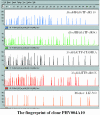Genome physical mapping from large-insert clones by fingerprint analysis with capillary electrophoresis: a robust physical map of Penicillium chrysogenum
- PMID: 15767275
- PMCID: PMC1065262
- DOI: 10.1093/nar/gni037
Genome physical mapping from large-insert clones by fingerprint analysis with capillary electrophoresis: a robust physical map of Penicillium chrysogenum
Abstract
Physical mapping with large-insert clones is becoming an active area of genomics research, and capillary electrophoresis (CE) promises to revolutionize the physical mapping technology. Here, we demonstrate the utility of the CE technology for genome physical mapping with large-insert clones by constructing a robust, binary bacterial artificial chromosome (BIBAC)-based physical map of Penicillium chrysogenum. We fingerprinted 23.1x coverage BIBAC clones with five restriction enzymes and the SNaPshot kit containing four fluorescent-ddNTPs using the CE technology, and explored various strategies to construct quality physical maps. It was shown that the fingerprints labeled with one or two colors, resulting in 40-70 bands per clone, were assembled into much better quality maps than those labeled with three or four colors. The selection of fingerprinting enzymes was crucial to quality map construction. From the dataset labeled with ddTTP-dROX, we assembled a physical map for P.chrysogenum, with 2-3 contigs per chromosome and anchored the map to its chromosomes. This map represents the first physical map constructed using the CE technology, thus providing not only a platform for genomic studies of the penicillin-producing species, but also strategies for efficient use of the CE technology for genome physical mapping of plants, animals and microbes.
Figures

Similar articles
-
A BAC/BIBAC-based physical map of chickpea, Cicer arietinum L.BMC Genomics. 2010 Sep 17;11:501. doi: 10.1186/1471-2164-11-501. BMC Genomics. 2010. PMID: 20849583 Free PMC article.
-
Genome physical mapping with large-insert bacterial clones by fingerprint analysis: methodologies, source clone genome coverage, and contig map quality.Genomics. 2004 Dec;84(6):941-51. doi: 10.1016/j.ygeno.2004.08.014. Genomics. 2004. PMID: 15533711
-
Construction and characterization of a soybean bacterial artificial chromosome library and use of multiple complementary libraries for genome physical mapping.Theor Appl Genet. 2004 Sep;109(5):1041-50. doi: 10.1007/s00122-004-1712-y. Epub 2004 May 26. Theor Appl Genet. 2004. PMID: 15164176
-
Optical mapping and its potential for large-scale sequencing projects.Trends Biotechnol. 1999 Jul;17(7):297-302. doi: 10.1016/s0167-7799(99)01326-8. Trends Biotechnol. 1999. PMID: 10370237 Review.
-
Mapping and sequencing complex genomes: let's get physical!Nat Rev Genet. 2004 Aug;5(8):578-88. doi: 10.1038/nrg1404. Nat Rev Genet. 2004. PMID: 15266340 Review. No abstract available.
Cited by
-
A first generation BAC-based physical map of the Asian seabass (Lates calcarifer).PLoS One. 2010 Aug 5;5(8):e11974. doi: 10.1371/journal.pone.0011974. PLoS One. 2010. PMID: 20700486 Free PMC article.
-
Genome physical mapping of polyploids: a BIBAC physical map of cultivated tetraploid cotton, Gossypium hirsutum L.PLoS One. 2012;7(3):e33644. doi: 10.1371/journal.pone.0033644. Epub 2012 Mar 16. PLoS One. 2012. PMID: 22438974 Free PMC article.
-
A BAC/BIBAC-based physical map of chickpea, Cicer arietinum L.BMC Genomics. 2010 Sep 17;11:501. doi: 10.1186/1471-2164-11-501. BMC Genomics. 2010. PMID: 20849583 Free PMC article.
-
A physical map of the papaya genome with integrated genetic map and genome sequence.BMC Genomics. 2009 Aug 7;10:371. doi: 10.1186/1471-2164-10-371. BMC Genomics. 2009. PMID: 19664231 Free PMC article.
-
Recent advances in cotton genomics.Int J Plant Genomics. 2008;2008:742304. doi: 10.1155/2008/742304. Int J Plant Genomics. 2008. PMID: 18288253 Free PMC article.
References
-
- Zhang H.-B., Wu C. BAC as tools for genome sequencing. Plant Physiol. Biochem. 2001;39:195–209.
-
- Meyers B.C., Scalabrin S., Morgante M. Mapping and sequencing complex genomes: let's get physical. Nature Rev. Genet. 2004;5:578–588. - PubMed
-
- Wu C., Sun S., Lee M.-K., Xu Z., Ren C., Zhang H.-B. Whole genome physical mapping: an overview on methods for DNA fingerprinting. In: Meksem K., Kahl G., editors. Handbook of Plant Genome Mapping: Genetic and Physical Mapping. Weinheim, Germany: Wiley-VCH Verlag GmbH; 2005. pp. 257–284.
-
- The International Human Genome Mapping Consortium. A physical map of the human genome. Nature. 2001;409:934–941. - PubMed
-
- Marra M., Kucaba T., Sekhon M., Hillier L., Martienssen R., Chinwalla A., Crockett J., Fedele J., Grover H., et al. A map for sequence analysis of the Arabidopsis thaliana genome. Nature Genet. 1999;22:265–270. - PubMed

